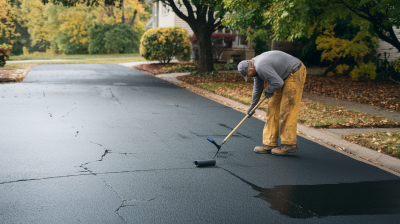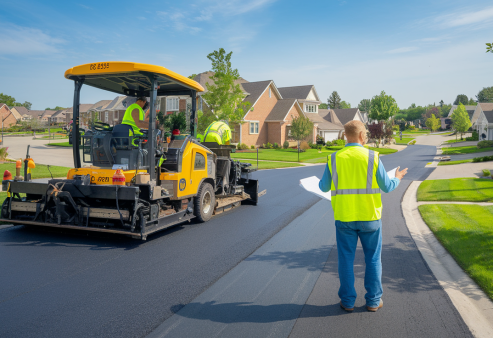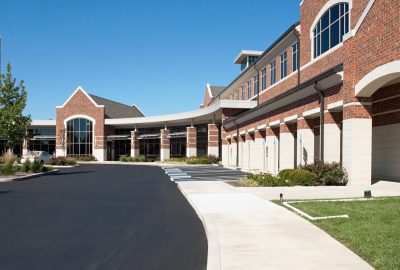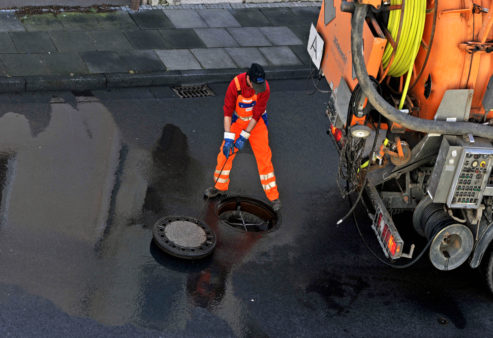Asphalt vs. Gravel: Which is Better for Your Property?
Table of Contents: 1. Key Takeaways 2. Asphalt or Gravel: Key Differences a. Composition and Texture b. Maintenance Requirements c. Weather Performance 3. Understanding Asphalt Pa...

Experienced Professionals Delivering High-Quality Asphalt Services
Residential License # 890459
Commercial License # 3667

Call Us Today!
1. Key Takeaways
2. Recognizing Early Signs of Asphalt Wear
3. Inspection Techniques for Early Damage
4. Ensure Your Pavement Remains in Optimal Condition
If you catch asphalt degradation early, you can prevent expensive repair work and extend your pavement’s life. Although these indications are minor (i.e., hairline cracks, coloration in your asphalt, standing water, uneven surface, etc.), they are nevertheless indications of the beginning of asphalt degradation.
In New Orleans, for instance, the aging can accumulate with the extra level of environmental pressure (persistent and heavy rains, very humid, etc), therefore, the implementation of periodic inspections becomes indispensable.
Spotting these issues early allows timely maintenance, reducing risks like potholes or structural failure. TurnKey Asphalt will walk you through the signs to look for and how to fix the issues the right way. Reach out to us today to schedule an inspection, and let’s keep your asphalt in top shape for years to come.

Residential and commercial asphalt surfaces are constantly, relentlessly subjected to heat, snow, and salt. While these conditions can be fixed early, it is not only in the best interest of maintaining the pavement; it’s also for safety and appearance. Here are a few warning signs to look out for.
One of the initial indications of failure in asphalt is typically cracking. It doesn’t take long before traffic, severe thermal fluctuations, or simply time itself can create some minor surface cracking that must be prevented. Though these seem like minor problems at first, they can quickly get out of hand, particularly with repeated freeze-thaw conditions.
Edge cracking, which is cracking that takes place along the edges of pavement, is common and is usually due to overloading or insufficient support. When not addressed, water may seep into these cracks, expand in lower temperatures, and worsen the issue.
Surface fade, usually gray or dull, often shows that the surface asphalt binders have weathered due to UV radiation and oxidation exposure. The asphalt has been weakened since it starts to become brittle and prone to cracking. Sealcoating can thus be reapplied to restore and shield the asphalt surface from harm.
Water pooling in low areas or drainage issues after rainfall is a warning sign. This might be a sign of water ponding or drainage issues, or rutting—it only gets worse as it ages. Left unchecked, standing water will wear down the asphalt much faster and create a much greater risk of potholes developing.
Depressions or uneven areas are usually caused by poor installation technique or a weak base layer. These asphalt patches often deteriorate further with vehicle loading and must be replaced to avoid future structural damage.
If you notice a harsh ride or loose gravel, that’s an indicator that the surface is deteriorating. This can often be observed within months of improper installation or with the normal aging of asphalt. As part of routine maintenance, regular sweeping or cleaning can minimize debris problems.

Pre-treating asphalt deterioration when it is still manageable starts with inspections. Routine inspections uncover early damage before it becomes a problem. These are some methods specifically aimed at optimizing long-term pavement health.
By doing a simple visual inspection every three to six months, homeowners can catch any damage before it causes real problems. Inspect existing cracks. Look for hairline cracks, no wider than 1/4 inch, because these can widen rapidly if not addressed. Particularly look along the edges of driveways or parking lots, as heavy vehicles or inadequate underlying support can cause stress fractures.
To further investigate, more rudimentary tools such as a straightedge or feeler gauge can be employed. They can identify areas of settlement or ridges that would not be noticeable otherwise. A simple screwdriver can be used to test the firmness of the pavement.
If you see large areas of cracking or deep ruts, or the pavement appears to be failing quickly, call in a paving professional. General contractors determine subgrade stability and suggest targeted repairs. They might recommend crack filling or full-depth reclamation to bring back the structural integrity before the damage has time to propagate.
The earlier you catch an asphalt issue, the less time and money it will cost you. Cracking, discoloration, standing water, or a bumpy appearance are red flags. Regular inspections and timely maintenance can keep minor issues from becoming costly repairs. Addressing problems early also helps maintain your property’s appearance and value.
If you notice any visible wear or require additional help, call TurnKey Asphalt, a reputable local asphalt expert, today. Obtaining professional guidance will ensure that your new parking lot or driveway will be safe, smooth, and last for decades.

Table of Contents: 1. Key Takeaways 2. Asphalt or Gravel: Key Differences a. Composition and Texture b. Maintenance Requirements c. Weather Performance 3. Understanding Asphalt Pa...


Avoiding the most common asphalt paving mistakes from the start helps prevent costly repairs and premature deterioration. Issues like improper base preparation, incorrect asphalt thickness, and poo...


Asphalt is also the most suitable for residential driveways since it can endure a long time and withstand heavy weights and extreme weather conditions without breaking up too much. It is also cheap...


Choosing the perfect material for your driveway is key to saving money and ensuring satisfaction with the final result. Both asphalt and concrete are popular options, each with its own set of advan...


Asphalt has proven its durability from ancient Roman roads to modern-day parking lots. Understanding its lifespan is key to saving money and maintaining the aesthetic of your property. Several f...


Proper drainage in asphalt is necessary for avoiding long-term damage caused by water standing on the surface. Standing water leads to cracks, potholes, and structural damage to the asphalt. Graded...
